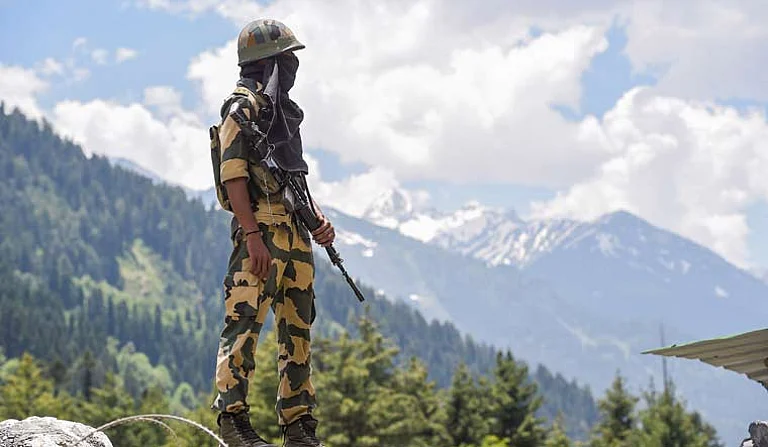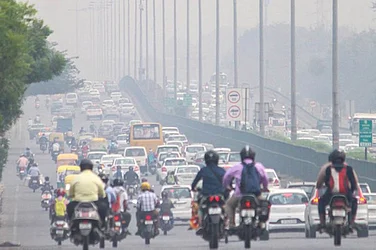The book of Gujarat opens with two cantos. The first, the great mercantile ethos, is a civilisational legend. The second, the equally great amnesia, survives in few memories. The first is about the business tycoons Gujarat is proud of, the second about the danseuses who could not become the state’s mascot. One is about the men who established oil refineries and ports, the second is about the men who founded academic and scientific institutions. The first tells us what Gujarat is, the second what it could have been.
And it applies to politics as well. When Digvijaya Singh was the Madhya Pradesh chief minister, he often advised young Congress MLAs, “If you want to be in politics, leave every other profession aside. Politics is a full-time job.” At the posh office of the Bharatiya Janata Party (BJP) in Ahmedabad last week, party spokesperson Jayesh Vyas shared an important distinction. “CVs of the north Indian politicians often have ‘social service’ as a profession. In contrast, most Gujarati politicians are into various professions,” Vyas told Outlook. “Your profession gives you satisfaction and social success. You may be a party leader, but you also want self-fulfilment,” he added.

The ethos pervades various spheres of life. Elsewhere, kids learn tables of 1, 2 and 3. In Gujarat, they also do dodh (1.5), sava be (2.25), pauna char (3.75) and the like. If it is all about dhandho (business), the great marketer will win politics too. It explains why despite both the Congress and the BJP firmly supporting the Sardar Sarovar Project, the BJP reaped the harvest. “The Congress couldn’t convince urban voters that it had brought the project and fought for it as well. The BJP and Narendra Modi have taken all the credit,” says Ahmedabad-based journalist Devanshi Joshi.
It also explains the BJP’s attack on Rahul Gandhi after Medha Patkar joined ‘Bharat Jodo Yatra’. For several decades, the Congress argued that Patkar ignored the state’s interests. How can you now accommodate her without explaining your change of stance to your voters?
The Myth Makers
Significantly, the Vaishyas (trader community) form just around 5 per cent of Gujarat’s population. But the mercantile trait is not community specific. It comes from a distinct coastal geography that organically pushes the resident to trade and entrepreneurship. Cambay and Surat had been India’s leading ports before the emergence of Bombay. The great Harappan port of Lothal was just 80 km from the modern Ahmedabad. A senior Gujarati academic underlines that over 80 per cent of teachers in colleges and universities have websites related to the stock market always opened on their computers. Be it journalists in newsrooms, or people at a funeral, the dominant conversation is dhandho.

The ‘Gujarat Model’, hence, is a marketing gem. The buyers ignore that the state always rode on high growth. When the nation was struggling under British rule, Gujaratis were doing great business and funding the freedom struggle, of which M.K. Gandhi’s Sabarmati Ashram was a prime example.
Contrarily, the state’s indices have slipped in the last two decades. At his Ahmedabad home, Hemant Shah, former principal of HK Arts College, shares the details of his well-researched book, Sachhai Gujarat Ki (The Truth of Gujarat). From 1980 to 2000, the average annual growth rate of Gujarat was around 15 per cent, while from 2001 to 2021, Modi’s period, it slipped to 8.21 per cent. With 919 women per 1,000 men, Gujarat has among the worst sex ratios in the country, substantially below the national average of 940. “The Gujarat Model is an illusion created through propaganda. It is a Disneyland model of governance to satisfy kids of all ages,” senior Gujarati journalist Urvish Kothari tells Outlook.
Another consoling myth is of vegetarianism. The BJP’s chief spokesperson Yamal Vyas proudly says that Gujaratis are vegetarian, ignoring the various surveys that say at least 40 per cent of the Gujaratis consume non-vegetarian food. Mahatma Gandhi is Gujarat’s most famous ambassador for vegetarianism. But his culinary habits were not native. His ancestral town of Porbandar has a predominant meat-eating culture. The port town’s economic and social life is dependent on fish. The town is lined with rows of trawlers and fishnets, with the smell of fish wafting in the air.

Similarly, notwithstanding the BJP’s repeated claims that the Congress destroyed Gujarat, the party does deserve some credit. India’s greatest cooperative movement that made the country the world’s largest milk producer happened under the Congress rule. It created India’s most adorable brand, Amul, and provided self-employment to millions of rural women, even prompting Shyam Benegal’s movie Manthan. Vyas listed the completion of the Sardar Sarovar Project among the party’s greatest achievements in the last five years. Never mind that the project was conceived during the Congress rule and its foundation stone was laid by Jawaharlal Nehru in 1961. Not to mention premier institutes like the Indian Institute of Management and National School of Design.
Sangh’s Spadework and Arrival of Modi
But myths alone cannot explain Modi’s sway. Even Hindutva is just one cog, though a major one, in the wheel. Before Modi arrived, the BJP–RSS had already laid the foundation by uniting the numerous OBC communities in the state under the Hindu umbrella. The BJP had also begun winning over the milk and sugar cooperatives, which were the backbone of the state’s rural life and were under the Congress’s dominance.
Third, the Sangh also co-opted various religious sects in the state that was already home to a Shankaracharya Pitha (Dwarka) and two jyotirlingas (Somnath and Nageshwar), besides being a major centre of Jainism. The Swaminarayans and Morari Bapus filled the religious vacuum of the upwardly mobile population in a rapidly growing Gujarat. Though these sects spoke a language of love and harmony, they allowed themselves to be appropriated by the BJP and overlooked the gradual othering of Muslims. The Hindutvaisation of the Gujarati middle class was thus distinct from north India. Being cushioned by a religious preacher with a benign image and moral lessons, it foreclosed any need for introspection.

Around that time, the Ahmedabad textile industry also marked a decline. The industry had created neighbourhoods of Hindu–Muslim workers. Their shared interests ensured that communal violence did not last long and people regrouped again. With the decline of the industry 1980s onwards, the Sangh Parivar could easily take the lower OBCs and the Dalits away from Muslims.
Notably, the Gujarati Muslims are not poor like those of Bihar or Uttar Pradesh. Reflecting the state’s ethos, they run several businesses, hotel chains and NGOs. The community once dominated the underworld and bootlegging business, of which Abdul Latif, whose life supposedly inspired Shah Rukh Khan-starrer Raees, was the poster boy. A Robin Hood-like figure, he was seen as a justice provider during communal riots. In 1987, facing several cases, including some under the National Security Act, he won from five different constituencies in the Ahmedabad municipal elections. It was perhaps the first instance of the Congress losing the Muslim vote.
The BJP immediately sensed a major target. When Latif was arrested in 1996, the then chief minister Keshubhai Patel was hailed as ‘Hindu Hriday Samrat’, a sobriquet the Congress could have never envisioned when its governments arrested Latif. Communal riots took place during the Congress rule as well. In fact, several Muslims say that many Congress workers are hostile towards the community. In 1969, Gandhi’s centenary year, the city of Ahmedabad, where he had made his great ashram, witnessed the worst communal riots the country had seen till then. But such violence was largely witnessed in urban centres. The massive land of Saurashtra was less communal than central Gujarat, and Kutch was even more peaceful. The 2002 riots mutated the state’s society as the communal violence reached the rural hinterland. Muslims were tactfully targeted in areas they were weaker.
However, the anti-Muslim stance alone cannot explain Modi. He also successfully established himself as a pan-Gujarat leader, a nath (protector). He skilfully exploited the anti-Congress sentiment that was always present in Gujarat and goes back to the Mahagujarat movement of the 1950s, a feeling that the Nehru government had wronged Gujarat by offering a clipped state. “Many Gujaratis had been living with a sense of injustice they faced by the Congress—towards Sardar Patel, the Narmada cause, a truncated Gujarat state. Narendrabhai restored the Gujarati asmita. Attacks on him only intensified the Gujarati pride,” says Jayesh Vyas.
As prime minister, Modi strengthened his claim. For a society that had not seen any pan-Indian leader since Independence, a community that believed Nehru was unduly favoured over Sardar Patel, Modi was the immaculate cultural–political brand. He could sell the desolate Rann of Kutch as a tourist destination. He could also show the Muslims their place.
But it has also made the party an ancillary unit. “They want to make Congress-mukt Bharat, but they are also making neta-mukt BJP. In Keshubhai’s time, there were several strong parallel chief ministers, including Pravin Togadia. But now no one knows about him,” says Kothari. Now, politics is about inventing new marketing strategies. One afternoon at the BJP office, Outlook met several students of the Ahmedabad School of Digital Marketing. The young girls handled social media platforms of the BJP as part of their “internship with a corporate”. They were apolitical a month ago, but the stint with the party had made them Modi’s fans.
Collective Amnesia
Mercantilism has dissuaded higher pursuits of learning. Social scientists Achyut Yagnik and Suchitra Sheth note in their book, The Shaping of Modern Gujarat, that the “single-minded focus on generating profits” led to a “steady decline of the intellectual tradition”, as “Gujarat has not seen another towering personality since the twelfth-century scholar Hemchandracharya”. They add that “the Gujarati word vediyo, which literally means ‘a person who has studied the Vedas’, has become synonymous with bookworm or a learned fool”. In 1936, the great scholar Muni Jinvijay commented, “The main aim of the people here (in Gujarat) is to figure out ways to make the most amount of money. That knowledge which enables them to achieve this aim is considered useful knowledge. All other knowledge, according to them, is useless.”

It leaves a few young writers who are experimenting with various genres anguished. “There is an absence of intellectual culture in Gujarat. You find people in Bengali or Marathi discussing the likes of Neruda and Marquez but not in Gujarati. Most young poets here write popular ghazals or mediocre romantic poetry. It helps them earn a name among the masses,” Mehul Devkala, a young Gujarati poet, tells Outlook.
And thus, the islands of excellence remain ignored. Rajni Kothari was the founder of one of India’s greatest academic institutes, the Centre for the Study of Developing Societies. A fellow Gujarati Dhirubhai Sheth was among the founding members and later became its director. Two of India’s greatest contemporary dancers, Mrinalini Sarabhai and Kumudini Lakhia, lived a few kilometres from each other for decades in Ahmedabad. The state has given some of the finest modern painters ranging from Bhupen Khakhar to Gulam Mohammed Sheikh and Tyeb Mehta, with Vadodara as a major centre for the arts. And above all, Vikram Sarabhai, the father of India’s space programme?
Several of these illustrious names could be the state’s brand ambassadors. During my travels in Gujarat, I asked academicians and writers: What accounts for the great amnesia about the state’s cultural treasures? Why was there hardly any obit in Gujarati media for Kothari or Sheth? One of the answers offered was that they did not influence Gujarati life, because they left for Delhi and wrote in English. “Gujarat unki karmbhoomi kabhi nahin raha (Gujarat was never their place of work)” was a reply over a traditional Gujarati dinner. Somewhat understandable, but contrast this with the Bengalis’ love for Amitav Ghosh or their embrace of Amitabh Bachchan as Banglar jamai (Bengal’s son-in-law) even though Jaya Bhaduri never lived in West Bengal.
If the native Gujaratis can be proud of the diaspora industrialists spread across the globe, the distance from scholars who moved to Delhi or London seems tragic. “We don’t celebrate our literary giants the way other languages do. People are not even aware of the difference between a newspaper columnist and a writer,” adds Devkala.
The biggest question Gujarat’s civil society faces is its silence over the 2002 riots. Gujarati Hindus are generally benevolent. One does not see everyday lawlessness, but the state has silently acquiesced to the Muslim becoming the invisible ‘other’. After 2002, a large number of Muslim victims came to the ghetto of Juhapura on the western edge of Ahmedabad. Unlike Delhi’s Seelampur, an urban slum of poor Muslims, Juhapura’s residents include business tycoons, builders and activists. During the 2002 violence, Justice M.H. Kadri, a serving judge of the Gujarat High Court, had to leave his official residence and seek shelter elsewhere.
“I teach the Constitution of India, but was forced to vacate my office in Naranpura and shift to Juhapura. Imagine my pain and sense of defeat,” says Sophia Khan, a senior activist, who has been working on gender and legal issues for decades. “My Muslim identity became prominent only after 2002. Before that, I was a citizen of a secular country. My icons were never based on religious identity. I had been living in a cosmopolitan locality since my birth,” she says, sipping coffee at Cafe Coffee Day near Judges Bungalow Road. These Muslims wear their Gujarati identity and underline that despite the ostracisation, they focused on education and business. Kherunnisa Pathan, a native of Bhavnagar district, lived with her parents in Chandkhera locality of Ahmedabad before they were forced to come to Juhapura in 2002. When I asked her whether the locality’s name is one word or two, she said in Sanskritised Gujarati: “Sanlagn (joined).”
Will the silence ever catch up with the Hindu Ahmedabad, especially those who drive all the way to Juhapura at night for a guilty bite of kebab at ‘Magic Chickens’? Will it be remembered that the creator of Hindi cinema’s most iconic image of a woman, Mother India, was a person named Mehboob Khan, born in a village of Surat? Will Wali Mohmmad Wali, the 17th century poet who wrote a poignant poem about separation from Gujarat, ever find a place in the pantheon of Gujarati asmita?
Parting from Gujarat leaves thorns in my chest
My heart-on-fire pounds impatiently in my breast
What cure can heal the wound of living apart?
His shrine, situated right opposite the police headquarters in Ahmedabad, was demolished by the rioters in 2002. On the other side of the city last week, a Gandhian volunteer at the Sabarmati Ashram was spinning the charkha, demonstrating how the wooden loom works. He also showed Gandhi’s river that had “turned into an artificial stream”. “It’s no longer our Sabarmati,” the old man said, pointing at the Narmada water that now feeds the Sabarmati.
In the ocean of amnesia, it is perhaps inevitable for the rivers to acquire new waters.
(This appeared in the print edition as "Decoding the Gujarati Psyche")
Ashutosh Bhardwaj in Ahmedabad, Porbandar and Dwarka

























